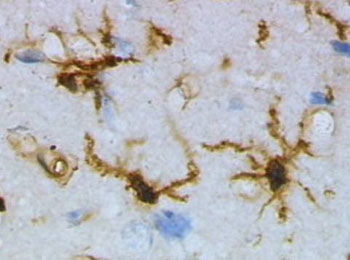CSF Biomarker Elevated in Early Stages of Alzheimer's Disease
By LabMedica International staff writers
Posted on 13 Mar 2016
Elevated levels of the soluble form of the TREM2 (triggering receptor expressed on myeloid cells 2) immune receptor protein in cerebrospinal fluid (CSF) have been linked to symptoms of early-stage Alzheimer's disease (AD).Posted on 13 Mar 2016
TREM2 is an innate immune receptor selectively expressed by microglia in the brain. It is a type-1 protein with an ectodomain that is proteolytically cleaved and released into the extracellular space as a soluble variant (sTREM2), which can be measured in the cerebrospinal fluid (CSF).

Image: Micrograph of microglia cells, which selectively express the TREM2 protein (Photo courtesy of Wikimedia Commons).
Investigators at Ludwig-Maximilians-Universitaet (Munich, Germany) examined whether CSF levels of sTREM2 were changed during the clinical course of AD, and in cognitively normal individuals with suspected non-AD pathology (SNAP). Over the course of the study, they analyzed CSF samples from more than 400 AD patients who showed cognitive defects of varying severity, and compared them with age-matched controls.
Results revealed that CSF sTREM2 levels were higher in mild cognitive impairment due to AD than in all other AD groups and controls. SNAP individuals also had significantly increased CSF sTREM2 compared to controls. CSF sTREM2 levels also increased with aging.
Elevated CSF sTREM2 levels were associated with higher CSF total tau and phospho-tau181P, which are markers of neuronal degeneration and tau pathology. At the mechanistic level, the investigators found that loss-of-function of TREM2 impaired the phagocytic activity of microglial cells and reduced clearance of amyloid beta-peptide (A-beta), suggesting that TREM2 may play an important role in the development of AD pathology and neurodegeneration during the course of the disease.
"Our findings indicate that TREM2 plays an important role in the progression of Alzheimer's, and perhaps even other forms of dementia. It appears to be part of a defense mechanism that involves phagocytic cells that eliminate damaged nerve cells and toxic protein deposits, such as those made up of beta-amyloid peptides," said senior author Dr. Christian Haass, professor of metabolic biochemistry at Ludwig-Maximilians-Universitaet. "This correlates with the level of activity of the microglial cells, which falls off as the condition progresses. This in turn presumably means that less beta-amyloid and cell debris can be cleared away. We therefore believe that this biomarker provides us with a way to assess the capacity of innate immune cells in the brain to degrade and dispose toxic material."
The study was published in the March 3, 2016, online edition of the journal EMBO Molecular Medicine.
Related Links:
Ludwig-Maximilians-Universitaet







 assay.jpg)





